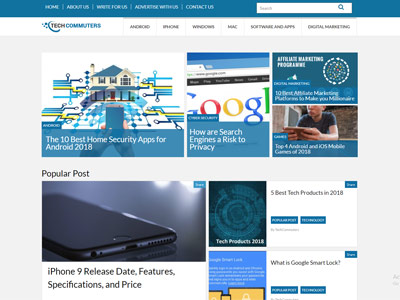The Best tech blog: Your Crucial Guide to Browsing the Digital World
The Best tech blog: Your Crucial Guide to Browsing the Digital World
Blog Article
Recognizing the Rise of Edge Computer in Today's Digital Globe
In the swiftly progressing landscape of modern technology, edge computer emerges as an essential force, reshaping exactly how data is processed and used. By transitioning information administration closer to the resource, side computing addresses important latency issues while optimizing data transfer usage and improving safety actions.
What Is Edge Computer
Side computer, although a relatively current development in the world of technology, essentially changes how data is processed and handled by bringing calculation and information storage closer to the location where it is needed. Unlike conventional cloud computer versions, which typically count on centralized information facilities that can be geographically remote, edge computer decentralizes information handling. This closeness decreases latency, boosts real-time data handling, and improves the total user experience by making sure quicker reaction times.
At its core, edge computer entails a network of local devices and infrastructure, such as sensing units, routers, and portals, efficient in processing data at or near the resource. This localized processing capability is specifically important for applications calling for immediate data analysis, such as autonomous automobiles, industrial automation, and smart cities. Additionally, by offloading data processing jobs from central servers, edge computing minimizes bandwidth demands and improves information personal privacy and safety, as delicate details can continue to be on-site as opposed to going across considerable networks.

Key Motorists of Fostering
Several factors are moving the fostering of edge computing in today's electronic landscape. Side calculating addresses this requirement by enabling information handling closer to the data source, decreasing latency and enhancing real-time decision-making capacities.
One more substantial driver is the need for improved data transfer performance. Central cloud systems can come to be overwhelmed with the sheer quantity of data created by IoT devices, leading to traffic jams (Best tech blog). By refining data at the side, organizations can ease network blockage and boost general system performance
Moreover, security and personal privacy issues are pressing organizations towards side computer. By processing sensitive information in your area, firms can minimize threats related to information transmission and direct exposure to potential cyber threats.
The rise of applications needing real-time handling, such as self-governing cars and boosted fact, also requires the rapid feedback times that border calculating provides. Jointly, these motorists are making side calculating an important element of modern IT framework, leading the way for its widespread adoption throughout numerous industries.
Benefits Over Cloud Computer
How does side computer identify itself from typical cloud computing? Mainly, edge computing brings information processing closer to the resource of data generation, often on regional devices or neighboring web servers, instead than relying on central data.
Furthermore, edge computing enhances data transfer effectiveness (Best tech blog). By refining data locally, only the necessary information is transmitted to the cloud for further analysis or storage, lowering the quantity of information that traverses the network. This not only minimizes network blockage but also reduces information transmission costs
Side computing also provides enhanced data personal privacy and safety. Sensitive data can be refined locally without being sent to the cloud, reducing the exposure to potential cyber risks. This is especially valuable for industries taking care of personal info, such as medical care and financial solutions.
In addition, edge computer ensures higher strength and dependability. Local processing enables for continued procedure also when next page connectivity to the cloud is endangered, preserving crucial functions and services in spite of prospective network interruptions. These advantages collectively show side computer's transformative possibility in optimizing efficiency and protection in electronic communities.
Difficulties and Factors To Consider
While edge computing uses numerous benefits, it also offers one-of-a-kind difficulties and considerations that should be dealt with to totally realize its potential. One substantial challenge is data safety and security and privacy. Handling information better to the resource enhances the danger of unapproved gain access to, demanding durable security and rigorous protection methods to safeguard sensitive information. Additionally, managing and keeping an eye on a decentralized network of side devices can be complex, needing sophisticated devices and techniques to ensure smooth procedure and maintenance.
One more factor to consider is the scalability of side computing remedies. As the variety of connected gadgets grows, so does the demand for refining power at the side, which can cause source constraints. Organizations should carefully prepare their infrastructure to fit this development without endangering performance or effectiveness.
Interoperability is an additional important factor. With different equipment and software program parts involved, making certain compatibility and smooth assimilation can be difficult. Standardization efforts are vital to facilitate communication between disparate systems.
Future Fads in Side Computing
Anticipating the future, side computer is poised to change numerous sectors by allowing quicker information handling and decreasing latency. As the volume of information created by IoT devices proceeds to expand, side computer will certainly become increasingly important in handling this influx successfully.
Another arising trend is the development of edge-native applications designed particularly to leverage the distinct abilities of side computer. These applications will certainly enhance efficiency and source use, resulting in boosted effectiveness across different markets. Advancements in 5G modern technology will certainly further reinforce side computer by supplying the required facilities for high-speed, low-latency interaction in between devices and edge nodes.
Conclusion
Edge computer's surge is driven by the proliferation of IoT gadgets and the need for real-time data handling, which improves efficiency by minimizing latency and decentralizing information monitoring. This technique reduces data transfer inadequacies and protection issues, helping with improvements in applications like smart click here for more cities and independent cars. Regardless of difficulties such as infrastructure intricacy and combination, the future of side computer promises a much more receptive electronic community, with continued innovations forming its development and expanding its applicability across sectors.
Side computer, although a fairly recent improvement in the realm of internet technology, basically transforms how data is refined and handled by bringing computation and information storage space closer to the place where it is needed. Unlike typical cloud computing versions, which usually count on central data facilities that can be geographically remote, edge computing decentralizes information handling. Furthermore, by offloading data handling tasks from central web servers, side computing minimizes data transfer requirements and improves information privacy and protection, as delicate information can stay on-site instead than traversing considerable networks.

Report this page